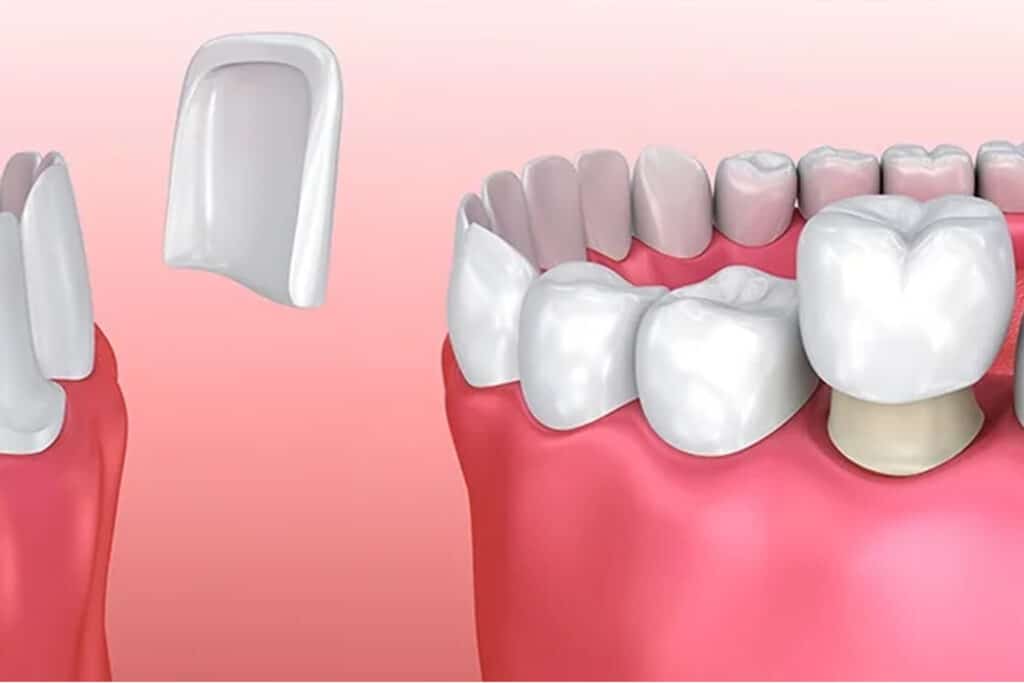Just because you don’t have a perfect set of pearly white teeth doesn’t mean you can’t have a smile to be proud of. Porcelain veneers and crowns are a way to let you have a smile you don’t have to hide.
Keep reading to find out more about porcelain veneers and crowns, what they’re made out of, and how they can change your smile.
What Is a Porcelain Veneer?
 Porcelain veneers started in Hollywood to help stars have the perfect smile during filming. They are thin shells that cover the front of your teeth and help improve your smile by helping it both look and feel strong and healthy.
Porcelain veneers started in Hollywood to help stars have the perfect smile during filming. They are thin shells that cover the front of your teeth and help improve your smile by helping it both look and feel strong and healthy.
No two mouths are exactly the same, so porcelain veneers are custom made for each patient and can cover up any undesirable color, shape, or contour of your natural teeth. If you have small gaps in your teeth, and you’re too impatient or just don’t like the idea of orthodontics, veneers can be made to cover those gaps too.
A veneer isn’t as invasive as a crown because the preparation for it leaves most of your tooth intact. A small portion of your tooth’s surface is ground down, and then a thin layer of porcelain is added to your tooth, which is the veneer.
What Is a Porcelain Crown?
 Porcelain crowns provide the same benefits as a veneer but are slightly different. Where veneers cover only the front of the tooth, a crown replaces the entire external portion of the tooth down to the gum.
Porcelain crowns provide the same benefits as a veneer but are slightly different. Where veneers cover only the front of the tooth, a crown replaces the entire external portion of the tooth down to the gum.
Crowns use slightly thicker porcelain than veneers and are fused to a metal alloy to make it stronger and stay in place. Because a porcelain crown covers the entire tooth, more of your tooth needs to be ground down before attaching a crown.
What Are Porcelain Veneers and Crowns Made Of?
Porcelain is a type of pottery. It is made from clay and can include other materials like feldspar, glass, quartz, petuntse, and alabaster. The biggest attribute that makes porcelain a better option compared to other materials is that it allows light to pass through it, which helps it mimic your natural teeth so well.
In both veneers and crowns, porcelain is created between visits. At the initial consultation visit, the patient will get measured and molds will be taken of their teeth. After preparing the tooth for a crown, the dentist will place a temporary crown to help protect the tooth, which is now quite sensitive. The dentist may also place a temporary veneer after preparing the tooth for a veneer. The temporary crown or veneer will be removed once the real one is custom made and ready for application.
The molds and measurements are then used to create the porcelain by sculpting and painting the new veneer or crown. Painting is necessary because even the healthiest teeth aren’t pure solid white. After they are painted, they are then cured or fired, so they are strong enough to be used as your teeth.
What Are the Benefits of Porcelain Crowns?
Getting a porcelain crown can help your overall oral health, as well as provide a cosmetically healthy smile. Porcelain crowns can help with:
- Improving the look of severely stained teeth
- Replacing missing teeth
- Repairing cracked teeth
- Repairing eroded or smaller teeth
- Strengthening weakened teeth
The overall look of porcelain crowns is one of their biggest benefits. They are custom color-matched to your existing teeth which makes them look like your natural teeth. If you want a better-looking smile, chances are that porcelain crowns can help.
Are Porcelain Crowns the Same As Porcelain Veneers?
No, porcelain crowns and veneers are not the same things. They are both made from porcelain and are used in cosmetic dentistry, but they are different in how much of the tooth they cover. Porcelain veneers cover the front of the tooth while porcelain crowns cover the entire tooth.
What Are the Drawbacks of Porcelain Veneers and Crowns?
It’s important to know that once you have had your tooth prepared for the veneer, the process is not reversible. Once you have a veneer or crown, that is what you will have for the rest of your life. If the porcelain cracks, breaks or falls off, it must be repaired or replaced. In most cases, repair isn’t possible, so it requires a new veneer or crown to be crafted to replace the damaged one.
If you have habits like pen-chewing or nail-biting, you are going to have to stop them because these activities can chip or break the porcelain.
Veneers and crowns are also bad choices for patients with poor gum health. Because part of your tooth is still under the crown or veneer, you have to make sure that the root of your tooth is still healthy. If you have moderate to severe gum disease, it might not be possible for you to have a veneer or crown.
Some patients think a veneer or crown makes their tooth indestructible and nothing can go wrong, but they require just as much upkeep as your normal teeth. Making the decision to get veneers or crowns is a lifelong decision. Because your teeth can still be susceptible to decay it’s important that you maintain your oral health and visit a dentist regularly to make sure there is no chipping or long-term damage to the porcelain.
How Long Do Veneers Last?
Generally, a veneer lasts somewhere between five to twenty years. The studies show it depends on a number of factros including the condition of the tooth when starting, the experience of the dentist, and the maintenance by the patient. To help your veneers last longer, you should brush and floss daily as you would regularly do and make sure to maintain great oral health. A professional cleaning twice a year is also recommended. When your veneers do start to age, chip, crack, or break, you don’t have the option to go back to your natural teeth. You will have to get new veneers.
How Can I Care for My Porcelain Dental Work?
The easiest way to make sure your dental work lasts is to treat them like your normal teeth. You can, and should, brush and floss like normal, and maintain your oral health.
Grinding your teeth can damage your veneers and cause chipping and breaking. Habits, like grinding your teeth, biting your nails, or even chewing on pens or pencils, should be stopped. If you grind your teeth while you sleep, you should use a bite guard to help protect your teeth once you get veneers or crowns.
While porcelain veneers and crowns are strong, it’s important to not put any extra strain on your teeth by eating very hard or crunchy foods. There is a risk that by biting into extremely hard foods, you might chip or damage the porcelain. You should also reduce drinking red wine, black tea, and coffee as well as tobacco usage to avoid staining the porcelain. Alcohol should be avoided in general because it will eventually damage the bonding material between the veneer or crown and your natural tooth.
Contact Us
If you’re thinking about porcelain veneers and crowns, contact Aesthetic Smile Reconstruction today. We’ll be happy to answer any of your questions over the phone or schedule a consultation appointment with Dr. Sutera to see how you can get those pearly whites you’ve always dreamed of.


